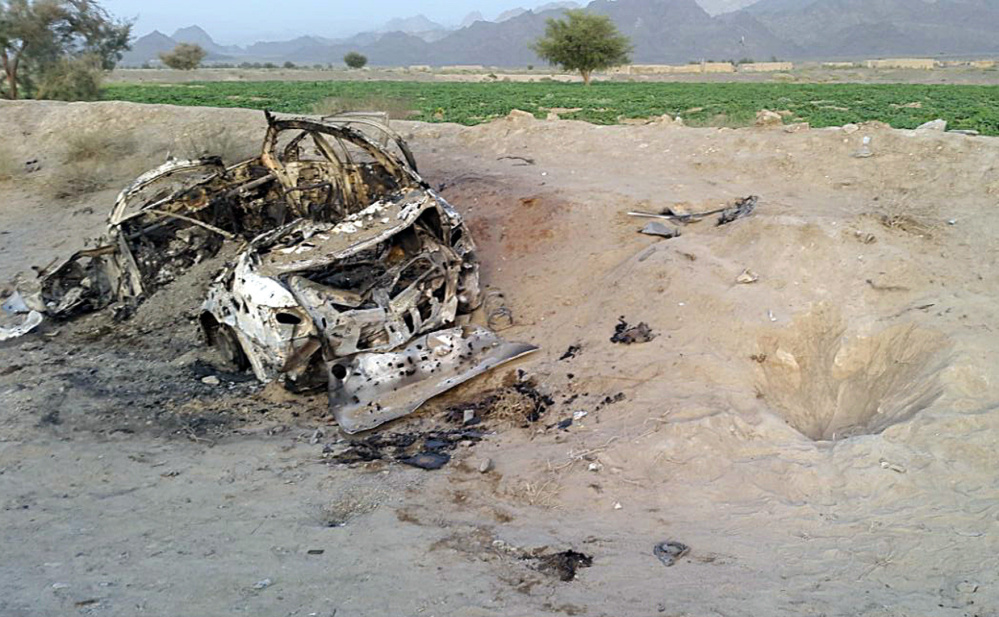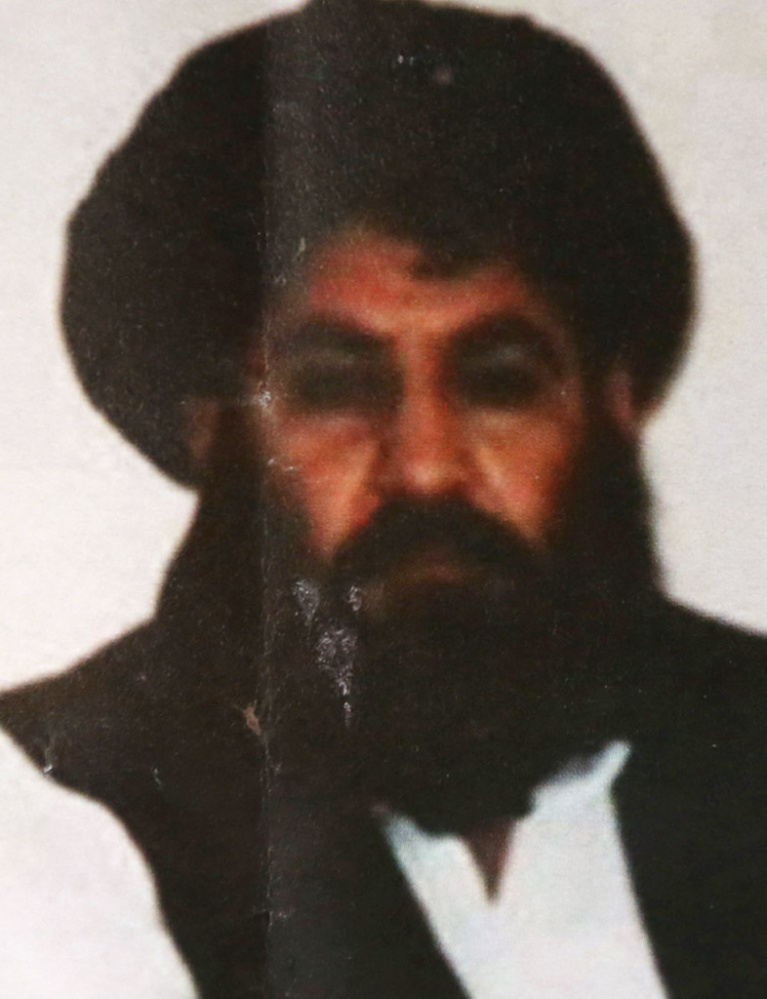ISLAMABAD, Pakistan — The U.S. airstrike thought to have killed Taliban chief Akhtar Mohammad Mansour over the weekend represents another escalation in U.S. involvement in the war in Afghanistan by trying to cripple an insurgent group that has for years found refuge on Pakistani soil.
Although U.S. officials were awaiting final confirmation of Mansour’s death, the strike early Saturday marks the most aggressive U.S. military action in Pakistan since the 2011 raid that killed Osama bin Laden. It is also believed to be the first time that the U.S. military has directly targeted the top leader of the Afghan Taliban, a potentially destabilizing action that could leave the group violently lashing out as it seeks to find a new leader.
“This is an unprecedented move to decapitate the Taliban leadership in its safe haven of Pakistan,” said Bruce Riedel, a South Asia expert of the Brookings Institution. “It exposes Pakistan’s role in promoting and protecting the Taliban, and will provoke a crisis in U.S.-Pakistan relations.”
But unlike the bin Laden raid, which prompted outrage in Pakistan, the reported airstrike on Mansour provoked a fairly muted reaction Sunday from Pakistani government and military leaders, even as Afghan officials cheered and described the attack as proof of the Afghan Taliban’s deep presence in Pakistan.
“While further investigations are being carried out, Pakistan wishes to once again state that the drone attack was a violation of its sovereignty,” the country’s foreign office said in a written statement that also noted it was unable to confirm whether Mansour had been killed.
What the apparent blow means for the Taliban remains uncertain. When Mansour took over after the death of former Taliban leader Mohammad Omar was announced last year, he had already effectively been running the group for two years, said Wahid Mozhda, a former Taliban diplomat who is now a political analyst in Kabul.
Appointing a successor now may be more challenging, with Omar’s eldest son, Mohammad Yaqob, and top deputies Serajuddin Haqqani and Moulavi Habatullah Akhunzada likely vying for control.
If Mansour’s death is confirmed (some Taliban supporters deny he was killed) the strike will pose even more turmoil for an insurgency movement that was already showing signs of fraying, despite continued success on the battlefield.
For Taliban leaders, a key question is whether Saturday’s drone strike will be followed up by additional U.S. military actions in southwestern Pakistan.
Saad Muhammad, a retired Pakistani general who was Pakistan’s defense attache to Kabul from 2003 to 2006, said the Taliban will now face “a very difficult choice.”
“If they remain in Quetta, in their comfort zone, they will have to deal with some Pakistani pressure to leave,” he said. “But if they go out, they will have to deal with attacks that could be life-threatening.”
U.S. officials said the drone strike was justified because Mansour refused to negotiate with Afghan leaders and had been plotting to attack U.S. forces in Afghanistan.
“This action sends a clear message to the world that we will continue to stand with our Afghan partners as they work to build a more stable, united, secure and prosperous Afghanistan,” Secretary of State John F. Kerry, who was traveling in Burma, said in a statement Sunday.
In a statement late Saturday, the Pentagon said several unmanned U.S. aircraft struck a vehicle in which Mansour was traveling in western Pakistan’s Baluchistan province. Local officials in Baluchistan said they recovered a charred vehicle and two bodies.
The passenger, suspected of being Mansour, had a Pakistani passport registered to an address in Karachi. The other man was apparently a taxi driver, local officials said.
“On Thursday night, he told me that he’ll be on a long drive with a passenger coming from Afghanistan,” said Mohammad Qasim, the brother of the driver. “I don’t know anything other than that.”
Afghan President Ashraf Ghani was in Qatar for a two-day state summit. But Ghani’s spokesman described the strike as a potential turning point in the 14½ -year-old Afghanistan conflict.
“This shows the strong U.S. resolve in fighting those who are against peace and are terrorists,” said Dawa Khan Mina Pal, the spokesman.
After a truck bombing in Kabul about a month ago that killed at least 64 people, the Afghan president signaled that he may try to get the United States to expand the war into Pakistan. In a speech before parliament, Ghani said he had all but given up on the peace process and urged Pakistan to take decisive action against Taliban militants on its side of the border.
If Pakistan failed to act, he warned, Afghanistan would call for “responsible international entities” to “act outside of Afghanistan against the criminals whose hands are stained in the blood” of Afghans.
But with just 9,800 American troops on the ground, Obama has been trying for months to transition the U.S. military out of direct offensive action in Afghanistan.
About 6,600 troops are based in Afghanistan as part of the NATO mission to train Afghan security forces. The remaining U.S. troops are stationed there for counterterrorism missions targeting al-Qaida and the Islamic State. The U.S. does not officially designate the Afghan Taliban as a terrorist group.
But under their rules of engagement, U.S. forces are allowed to take defensive action when threatened by the Taliban.
It was not clear how a kill-strike against Mansour in Pakistan fits into the criteria. Most previous U.S. drone strikes in Pakistan were carried out by the CIA in the northwestern tribal belt.
“This presented an opportunity to eliminate the threat Mansour posed,” said Brig. Gen. Charles H. Cleveland, chief spokesman for the U.S-led coalition.
Noting the limited reaction Sunday in Pakistan, some Pakistani analysts wondered whether Pakistan’s military could have secretly sanctioned the airstrike.
Muhammad, the retired Pakistani general, said he doubts Pakistan wanted Mansour killed.
“Obviously, they want a Taliban group that remains united because, if fragmented, it becomes much more difficult to control,” said Muhammad, who still stays in contact with some elements of the Taliban leadership. “This will create a very difficult situation for Pakistan, especially due to expectations Pakistan should bring them to the peace table.”
Mansour brought the leadership of the Haqqani network, a somewhat independent offshoot of the Taliban that the United States considers a terrorist group, into his command structure. Coalition commanders have said that Sirajuddin Haqqani, who was named Mansour’s top deputy, is taking a leading role in planning battlefield strategy .
Some Afghan analysts believe that Haqqani, known for employing especially brutal tactics against coalition forces and foreigners, is now well-positioned to assume full control over the Taliban. But Mansour’s other two deputies, Akhundzada and Yaqob, are also considered top contenders for the job.
Both Muhammad, the retired Pakistani general, and Mozhda, who worked as diplomat when the Taliban controlled Kabul before 2001, think Yaqob would have the upper hand in a leadership struggle.
Muhammad noted that most senior Taliban commanders come from southern Afghanistan and would seek to install a leader from that same region. Haqqani is from eastern Afghanistan.
Adbul Qayoum Zakir, a former Guantanamo Bay detainee and member of the Taliban executive council, could be a dark-horse candidate, Muhammad said.
Regardless, the leadership struggle may not be accompanied by a lull in violence.
After Omar’s death was announced last summer, the Taliban launched three major attacks in Kabul within 24 hours, killing more than 50 people.
Send questions/comments to the editors.




Success. Please wait for the page to reload. If the page does not reload within 5 seconds, please refresh the page.
Enter your email and password to access comments.
Hi, to comment on stories you must . This profile is in addition to your subscription and website login.
Already have a commenting profile? .
Invalid username/password.
Please check your email to confirm and complete your registration.
Only subscribers are eligible to post comments. Please subscribe or login first for digital access. Here’s why.
Use the form below to reset your password. When you've submitted your account email, we will send an email with a reset code.